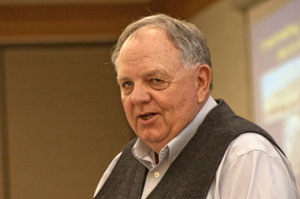Crossbreeding: No Free Lunch
Changing industry needs have created opportunity for Angus genetics.
by for Angus Productions Inc.
GERING, Neb. (Nov. 28, 2011) — Factors contributing to the increasing prevalence of Angus genetics in U.S. cow herds were discussed Monday evening during a Certified Angus Beef LLC (CAB) event hosted prior to the kickoff of the 22nd Range Beef Cow Symposium in Mitchell, Neb.

“There are places crossbreeding works extremely well," said Lary Corah, "but others have gone a simpler route of using a commercial black Angus-based herd — and that trend continues to increase.” Corah shared highlights of a white paper compiled by Nevil Speer of Western Kentucky University.Referencing a paper compiled by Western Kentucky University professor Nevil Speer, CAB’s Larry Corah noted that 50% of the national cow herd is currently classified as being high-percentage or straight British (Angus, Hereford, etc.), and 75% of cow herds in the U.S. today utilize some Angus genetics.
Speer's white paper addressed the question: Why are about half the producers in the United States using a commercial Angus herd when crossbreeding offers hybrid vigor advantages? The paper, titled “Crossbreeding: A free lunch, but at what cost?," outlines the present-day changes in genetics, marketing and costs that have prompted producers to use commercial Angus genetics rather than crossbreeding.
“There are places crossbreeding works extremely well," Corah said, "but others have gone a simpler route of using a commercial black Angus-based herd — and that trend continues to increase.”
Corah stated, “Cattle genetics today are dramatically different than they were 10 years ago. Producers can do things within breeds that they could only do with crossbreeding five to 10 years ago.”
He also noted that today's genetics offer more predictability than what was available in the past. He said, “The vast majority of first-calf heifers are bred to Angus because they offer predictable genetics.”
Additionally, Corah shared that research has shown not all heterosis is positive — with birth weight being a prime example.
“Heterosis adds pounds to weaning and yearling weights," he allowed, "but it also adds 1.6 to 1.7 additional pounds of birth weight.”
Another factor that he credits toward the increasing use of straight commercial Angus genetics is convenience.
“Many operations are not very big, so simplicity is important. Often they see straight Angus as easier to use than crossbreeding to manage their available time and labor and for understanding EPDs (expected progeny differences).”
Lastly, Corah noted that quality is still king in the marketplace.
“People expect a positive eating experience,” he said, adding that today’s market signals indicate that Prime quality and tenderness are gaining more attention. “They are becoming a bigger industry issue.”
Corah noted that Angus genetics have a proven track record of producing consistently high-quality beef. That reputation has bolstered the use of Angus genetics.
In closing, Corah shared a quote from Tom Brink of JBS Five Rivers Cattle Feeding, who has said: “We like cattle that are ¾ Angus and ¼ Continental — or — straightbred Angus steers. But in both cases, the important thing is to use the right genetics.”
Corah concluded, “Crossbreeding and the hybrid-vigor advantages it provides is solid science. But other production systems such as straightbred commercial Angus herds can — and are — being successfully used in the industry.”
To read Speer’s full research paper, visit www.CABpartners.com.
Editor's Note: This article was written under contract or by staff of Angus Productions Inc. (API), which claims copyright to this article. It may not be published or redistributed without the express permission of API, publisher of the Angus Journal, Angus Beef Bulletin, Angus e-List and Angus Beef Bulletin EXTRA. To request reprint permission and guidelines, contact Shauna Rose Hermel, editor, at 816-383-5270.

